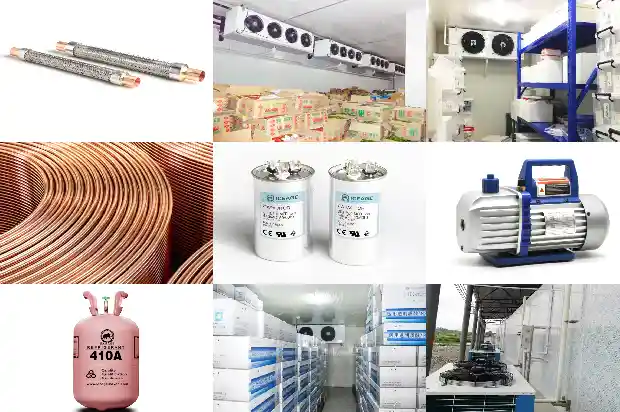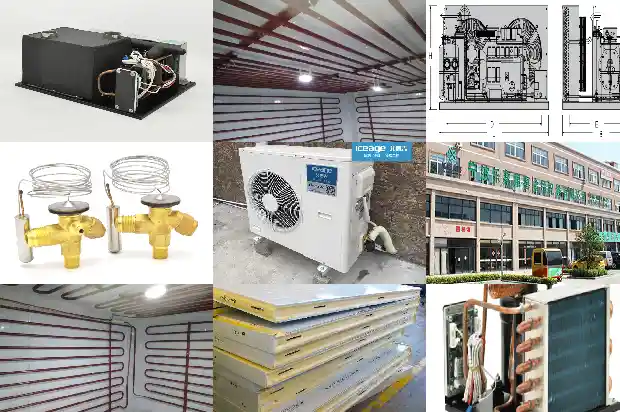What to Do if the Compressor of a Frozen and Refrigerated Display Cabinet Runs but the Refrigeration Effect Is Poor?
2025-02-20
For the frozen and refrigerated display cabinets in supermarkets, if it is found that the compressor is running but the temperature of the display cabinet fails to meet the requirements, and even the surface of frozen food softens, observe the operating pressure of the unit at this time. You may find that the discharge pressure is too high or too low, or the suction pressure is too high or too low. Let's analyze what factors can cause the unit's pressure to be too high or too low.
- If the discharge pressure is found to be too high, it may be caused by the following factors:
1.1 Air may have entered the refrigeration system, and the air in the system needs to be removed.
1.2 Excessive refrigerant has been charged (in this case, the suction pressure will also be very high), and the excess refrigerant needs to be released.
1.3 If it is a water - cooled condenser, scale may have adhered to the inlet pipe and the condenser pipes, and the condenser needs to be cleaned.
1.4 The cooling water volume is insufficient or the water temperature is high. It is necessary to increase the cooling water volume and clean the water pipes, water valves, and filters at the same time.
1.
5 Check whether the condenser cooling water pump and fan are operating normally.
1.6 If it is an air - cooled condenser, the air supply volume may be insufficient, the air temperature is high, or there is serious dust on the surface. Cleaning is required.
1.7 The compressor's discharge valve is not fully opened or the discharge pipe is blocked.
1.8 The liquid inlet valve of the liquid receiver may not be opened or not fully opened.
1.9 The oil - separating device has poor oil - separating performance, and there is excessive oil accumulation in the system.
1.10 Direct sunlight or poor ventilation in the machine room. Sun protection and good ventilation are required. - Factors causing the discharge pressure to be too low:
2.1 There is insufficient refrigerant in the system, and refrigerant leakage may also occur. It is necessary to find the leakage point, repair it, and replenish the refrigerant.
2.2 The cooling water volume of the condenser is too large or the water temperature is too low.
2.3 The installation position of the expansion valve's thermal bulb is incorrect.
2.4 The evaporator is excessively frosted, and defrosting is required.
2.5 The safety valve opens too early, and the opening pressure value of the safety valve needs to be adjusted.
2.6 Check whether the compressor's unloading capacity adjustment is malfunctioning. Adjust the unloading mechanism and the oil pressure.
2.7 Check whether the oil return valve of the oil separator is malfunctioning.
2.8 Check whether the discharge valve and suction valve are leaking. - Factors causing the suction pressure to be too high are:
3.1 The evaporator load is too large and does not match the compressor.
3.2 There may be a fault or leakage in the suction valve.
3.3 The piston rings of the compressor may be damaged.
3.4 The expansion valve opening is too large.
3.5 The installation of the expansion valve's thermal bulb is incorrect.
3.6 The compressor's unloading capacity adjustment fails.
3.7 Check whether there is a problem with the controller itself (open the pressure controller and check whether the pin is installed reversely or has fallen off). - If the suction pressure is too low, the following reasons may exist:
4.1 The evaporator load is too small, and a suitable evaporator needs to be selected.
4.2 The evaporator is blocked by frost or ice, and defrosting is required.
4.3 Check whether the evaporator has serious dirt and whether it needs to be cleaned.
4.4 The expansion valve opening is too small or the expansion valve is blocked. Clean the inlet filter of the expansion valve.
4.5 Check whether the expansion valve's thermal bulb is leaking.
4.6 The liquid - supply solenoid valve is not opened or the liquid pipe is blocked.
4.7 The liquid outlet valve of the liquid receiver is not opened or not fully opened.
4.8 There is insufficient refrigerant in the system. Check for leaks and replenish the refrigerant.
4.9 The compressor's suction valve is not fully opened or is blocked. Clean the suction filter screen and the valve hole passage.
4.10 The cooling fan is not turned on, or the fan rotates in reverse with insufficient air volume.
In conclusion, when the unit's operating pressure is abnormal, it is highly related to the operation of the device and daily maintenance. Be sure to check carefully and eliminate the problems one by one.
Related Articles
- Have You Encountered the Three Common Problems of Refrigeration Compressors?
- What to Do if the Compressor of the 【Refrigerated and Frozen Display Cabinet】 Unit Fails to Start?
- Precautions for Using Rotary Refrigeration Compressors
- How to Resolve the Scuffing Issue of Cold Storage Compressors
- Composition and Common Faults of Screw Refrigeration Compressors
- What Are the Causes of Scroll Compressor Damage?
- Do You Know These Four Scenarios That Can Cause Compressor Failures?
- What Are the Reasons for Insufficient Air Output of Screw Air Compressors?
- How to Solve the Problem of Frequent Shutdown and Startup of Cold Storage Compressors?
- How to Schedule Overhauls, Medium - sized and Minor Repairs of Screw Refrigeration Compressors?
- Why Can't Compressors Start Directly? What Are the Advantages of Soft Starters?
- Maintenance Methods for Faults in Screw Refrigeration Air - conditioner Compressors
- Solutions to Common Compressor Failures
- Effective Measures to Prevent Compressor Failures in Industrial Chillers
- Common Faults and Troubleshooting Methods of the Moving Mechanism of Piston Compressors
- Common Causes and Analysis of Compressor Thermal Protection
- Analysis of Common Faults in Compressor Overcurrent and Burnout
- Reasons for Pump Body Failures in Cold Storage Compressors
